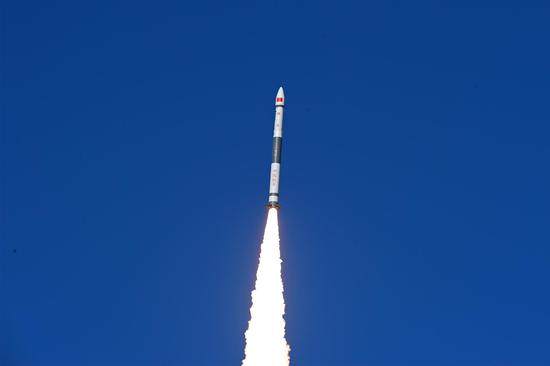An international collaborative team using two China space telescopes achieved an unprecedentedly precise measurement for a gamma-ray burst (GRB) that released about eight times the total rest-mass energy of the Sun in all directions in one minute.
The team, led by the Institute of High Energy Physics (IHEP) under the Chinese Academy of Sciences, Wednesday published the results that increased the brightness record of a gamma-ray burst by 50 times.
The gamma-ray burst coded GRB 221009A is the brightest one ever detected since the discovery of this immensely energetic explosion in distant galaxies, the most energetic and luminous electromagnetic event since the Big Bang.
In October 2022, it was detected by telescopes from Earth and space, including China's Large High Altitude Air Shower Observatory (LHAASO) and China's X-ray astronomy satellite Insight-HXMT (Hard X-ray Modulation Telescope).
"The burst, produced at a place 2.4 billion light years away from the Earth, is a rarely seen astronomical event due to its brightness and relatively close vicinity," said Zhang Shuangnan, Insight-HXMT's chief scientist and a researcher in the IHEP.
The GRBs with a longer duration (usually longer than two seconds) are generated by the collapse and explosion of stars with dozens of times the mass of the Sun. The short bursts are produced by the merger of two compact celestial bodies, such as black holes or neutron stars, which may also be accompanied by gravitational waves.
"Explosions of those two kinds will result in an extremely compact celestial object that produces two jets at a near speed of light in opposite directions," said Xiong Shaolin, the chief scientist of GECAM-C, the country's other space telescope launched into space in July of 2022.
"Therefore, we can only detect those radiations when one jet aims just right at the Earth," said Xiong, also from the IHEP.
Since 1967, nearly 10,000 gamma-ray bursts have been found. But an accurate measurement of the prompt emission properties of GRB 221009A is rather challenging owing to its exceptional brightness.
COMBINED OBSERVATIONS
In the new study, the Insight-HXMT and the GECAM-C or Gravitational Wave High-energy Electromagnetic Counterpart All-sky Monitor C, among other telescopes in the world, were employed to measure the transient radiations and early afterglow of this burst. The afterglow happened when burst jets were affected by the nearby interstellar medium.
The GECAM-C, a telescope specially designed for observations of gamma-ray bursts and an electromagnetic counterpart of gravitational waves, can avoid brightness-caused instrumental problems like data saturation and loss, signal stacking, and excessive dead time.
This telescope realized a complete and accurate probe of GRB 221009A's main emission, which dominates the burst in flux, in a soft gamma-ray energy band, while the Insight-HXMT did its part in hard X-ray band to acquire high-quality data about the burst's precursor radiation and early afterglow, said the researchers.
GECAM series space probes, using the short message service of China's BeiDou Navigation Satellite System to have realized satellite-to-Earth real-time communication, have detected a slew of high-energy explosions, including those from gamma-ray bursts, magnetic stars, fast radio bursts, solar flares, and terrestrial gamma-ray flashes.
Insight-HXMT, China's first X-ray astronomical satellite, sent into orbit in June of 2017, has made discoveries concerning black holes, neutron stars, and fast radio bursts over the past five years.
LHAASO, a giant cosmic ray detector located 4.41 km above sea level in southwest China's Sichuan Province, also contributed to the detection, and more findings will be published later, said the researchers.
The new joint observations have revealed that the afterglow's inflection point from the slow attenuation to a quick one appeared quite early, signifying that the burst-produced jet is very narrow, one of the narrowest gamma-ray bursts ever detected.
The results suggested that this burst may have a central engine, which could launch and collimate a very narrowly beamed jet with an ordinary energy budget, thus leading to exceptionally luminous gamma-ray radiation per unit solid angle, said the researchers.
"This work has opened a brand-new perspective for a deepened understanding of this extreme cosmic explosive event," said Zhang.


















































 京公网安备 11010202009201号
京公网安备 11010202009201号